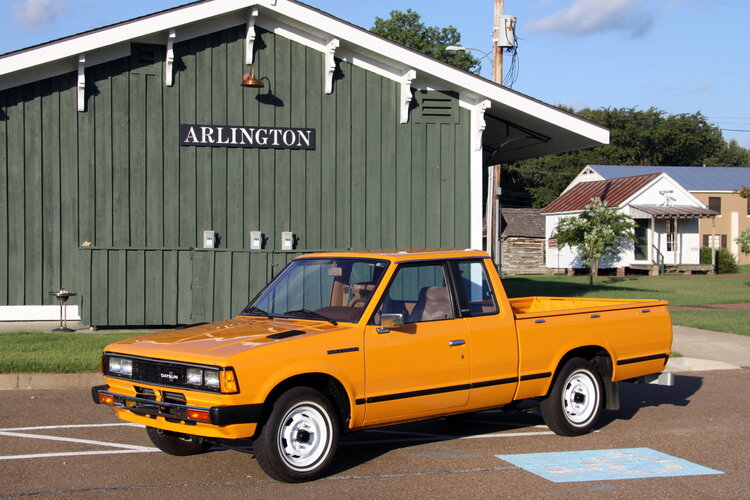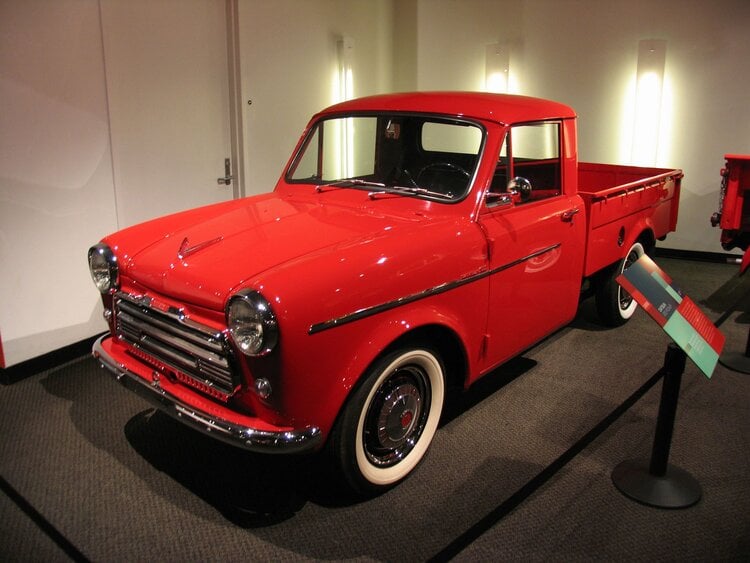History Of The Datsun Truck
Pickups from Datsun, Nissan’s alter-ego, are a favorite among Japanese collectors. We check out the best and worst Datsun trucks in this guide.

Jump To Section
Who Is Datsun?
Before we learn more about Datsun trucks, let’s know who Datsun is.
There are a lot of younger readers in our audience who just don’t know about the history of Datsun and its legacy in the market in the United States, Australia, and around the globe.
So, who is Datsun? Well, to put things simply, Datsun is Nissan. Or at least it was Nissan since Nissan Corporation decided to rebrand their cars from Datsun into Nissan for the vehicles to follow the same corporate name.
Nevertheless, the Datsun brand existed since 1931 as Datson but was later renamed Datsun. And the Datsun name means “Son Of DAT.” DAT is an acronym created from the first letters of the surname of the company’s three founders.
Nevertheless, Datsun was impressively popular in Japan in the 1930s, and after the war, the business was booming. There were pickups and sedans – the Datsun lineup quickly became rather extensive.
So, in 1958 they decided to enter the US market, more specifically, in California. Starting in 1959, they opened dealerships across the whole country.
And as the gas crisis hit in the early 70s, the need for small Japanese cars was booming in the American market, and the 70s and 80s were probably the two strongest decades for Datsun here in the US.
They competed with Chevrolet, Toyota, Ford, and many other brands. It also competed in other markets like Australia, the Middle East, and other overseas markets.
But what happened at the peak of their rise is that Nissan decided to axe the Datsun name. A big rebranding started in 1981, and this process was completed in the mid-80s.
But how did the Datsun truck fair through all of these vast changes?
Datsun Truck Timeline
This is where we learn more about the timeline of the Datsun truck, starting from the first Datsun truck to the last of the trucks that Datsun sold.
We will list the trucks and some of their specs and learn more about what these models offer. So, if you want to learn more, stick with us!
Datsun 120
The first Datsun truck that comes to our mind is the Datsun 120.
So, what is the 120? Well, the Datsun 120 is probably one of the most famous models that Datsun made back in the day.
This was not the first Datsun truck. But probably the most memorable one from the earlier models.
The 120 was based on the Datsun 1000 sedan, and the truck carried the same mechanicals, except for the rear end, which had a bed instead of rear seats.
Using the same chassis made the 120 models very affordable, and people loved them. These cute little trucks came only as a single cab, so, back in the day, there was no king cab as we have right now. Every was utilitarian and made to serve a purpose.

This model also implemented an excellent suspension setup that made the usage of this truck a true pleasure for work and driving around town.
And the main accent of these trucks was on reliability. They were reliable as they could get. These trucks also looked good, with a massive grille at the front.
This truck came with a variety of engines. But the most popular was probably the 988 cc inline-4 engine. That was also known as the stone engine. This engine was paired with a 4-speed manual transmission.
Overall, a really good example of a Datsun truck. Now let’s move on to the next Datsun truck.
Datsun 320
The next Datsun truck that we chose to cover is the Datsun 320. We skipped the 220 because it is only a mild upgrade over the original 120 truck. So, there is not a substantial difference between the two. This is why we will dive straight into the 320 models.
This is the model that was introduced in 1961, and this model stayed in production until 1965.
The base of the truck was the Datsun Bluebird 310 sedan. Nevertheless, this model incorporated greatly improved suspension.
It kept the same A-arm torsion bar independent front suspension with leaf springs at the rear end. However, this truck was overall more heavy-duty compared to its predecessor.
So, we can say that this was a beefed-up version of the 120.
Also, there were improvements under the hood as well.
This model included a more powerful engine. More specifically, the Nissan E-1 engine.
This was a 1.2L inline-4 engine that produced about 60 horsepower. And this model carried the badges “Datsun 1200” and “60 HP” to indicate that this model creates a lot of power.
And jokes aside, this was the case; 60 horsepower back in the day was a lot. This truck competed directly with the Mazda B-Series and the Toyota offerings back then.
What is interesting about this truck is that it was also a coupe utility version and a station wagon.
Now, let’s move on to the next Datsun truck.
Datsun 520/521
The 13th generation Datsun 520/512 takes a more modern approach.
The 520 models are based on the Bluebird 410, and the model was a revolutionary change in design language compared to the predecessors.
This was a full change from the dull 50s looks for something more modern. So, the new model implements a new modern grille with two big round headlights and a few choices in terms of exterior paint.
This model implements improved suspension, allowing a wheelbase extension of up to 60 mm and greater front and rear threads of 80 mm.
Unsurprisingly, with all these improvements, the drivability and comfort significantly improved.
There were also more engines to choose from. There was the base 1.3L inline-4. But there were also the 1.5L inline-4 and the 1.6L inline-4, with the most potent version producing up to 94 hp.
The standard transmissions were the 4-speed manuals, which performed well in any conditions.
Overall, the 520 and then the 521 productions successfully ran until 1972, when the model was replaced with the next Datsun truck that we will cover in the following chapter.
Datsun 620
Next up is the Datsun 620.
If you thought the 520 was revolutionary, we could say the 620 was even better.
This is the model that brought the most noticeable changes from any previous models. This model was introduced in 1971, and its production lasted until 1979.
It was produced globally and used in many countries, including the United States.
In Australia, these vehicles were known as Utes. In South Africa, they were known as Bakkies. Overall, they were a global hit.
And what was good about this model is that it was offered in various cab options in the US, and the model was known as the Lil Hustler.
Since it was rather small compared to other trucks regarding cab options, there was the standard single cab; there was a King Cab and an Extended cab like in most modern cars.
This model brought other innovations as well, like the front disc brakes, EGR system, long-bed, and a lot of other improvements.
The biggest improvement was probably in the engine and transmission department. The base engine was the L16, a 1.6L inline-4 producing 96 horsepower. But there was also the L18, a 1.8L inline-4 engine producing up to 100hp, and the most powerful model, the 2.0L L20B inline-4, produced 110 hp. Those are pretty beefy numbers for a vehicle of its size.
In the transmission departments were also some changes. There were 3-speed automatic— 4-speed, and 5-speed manual transmissions.
The 620 was a perfect and reliable model at the time—the perfect truck for people who wanted something different.
Datsun 720
The next Datsun truck we will cover is the Datsun 720 model. This was the model that replaced the 620 that we covered previously.
This truck significantly changed from the previous version since this model implemented a more contemporary look.
From the outside, this truck is screaming 80s. More specifically, the model was sold between 1979 and 1986 model years.
This truck was another global hit, selling everywhere worldwide, including in the US. There were many trim options, like the GL, DX, MPG, Lil Hustler, XE, and Bushmaster. Every trim carried something special. But the DATSUN logo on the tailgate was common for each one.
These trucks also featured a lower rear valance to complete the look between the tail lights.
Although, there were some cab variations like the Extended-Cab, King Cab, and the Regular Cab, which was the basic 2-door version.
In terms of engines, there was a big variety of powertrains to choose from. The base was the 1.5L inline-4. But there was also a 2.4L inline-4 that was also very popular, especially for the people who needed more power.
There were also a few transmission options, like the 4-speed manual transmission, which was the most popular. There were also a 5-speed manual and a 3-speed automatic.
Overall, this model was the last Datsun truck in the United States. As noted in the introduction, Nissan decided to rebrand all their lineups into Nissan. So, the Datsun name was axed even though the next model we will cover was also sold in Japan as the Datsun truck.
Datsun D21
Now let’s cover the last Datsun truck, the last of its kind. This was the Datsun D21. It was sold as the Datsun Truck in Japan, but in the US, it was sold under a different name—namely, the Nissan Pathfinder. Later on, this model became the Frontier that we know today.
This truck was an improved version of the previous generation. It was much more prominent in size and offered a lot of comforts; with more substantial front rear ends and enhanced ride comfort, this truck has finally started to look more like a truck for the American market.
And that was the case. This model offered a bigger frame and different cab layouts, like the Regular Cab, the standard 2-door version. Also, there was the King Cab. This truck was assembled locally in the US, just as the previous two generations at the Nissan Factory in Smyrna, Tennessee.
Even though it was large, it was still a compact truck since the wheelbase varied between 104.3 and 116.1 inches.
The overall length never surpassed 195.5 inches, and the model’s curb weight is 3,602 lb. Quite a bit heavier compared to its predecessors.
This increase in weight meant that there would be a need for larger engines. So, the new truck had powerplants starting from 1.6L and up to 3.0L in displacement.
There were also a variety of transmissions to choose from on this Datsun truck: two automatic and two manual options.
The automatic transmissions were 3-speed and 4-speed, while the manual models included 4-speed and 5-speed.
This model was discontinued in 1990, and unfortunately, this was the end of the Datsun truck globally.
Conclusion
This article thoroughly covered the Datsun truck from its humble beginnings to where the brand now exists within the Nissan lineup.
Firstly, we learned more about what is Datsun and learned some of the histories of the brand, this is one of the brands with the richest history in the US, even though it was canceled in the mid-80s.
In the second part of our article, we covered the Datsun truck models, starting from the 120 models to the most recent one released, known as the D21, the ancestor of the modern Nissan Frontier.
We discussed some of the specs and key features. What is good about these trucks is that you can find them on the used market and sites like Craigslist or eBay. So, make sure that you check them out.
















